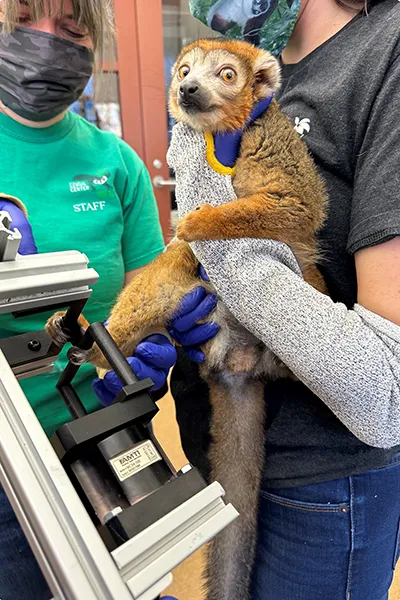Primate Research Reveals Unexpected Insight on Grip

A study by UT Assistant Professor Michael Granatosky suggests species such as lemurs evolved grasping hands and feet for versatility rather than strength.
New research led by Assistant Professor Michael Granatosky suggests some primates’ hands and feet are built for versatility, not just strength to grip branches as they move through trees.
Although lemurs and other strepsirrhine primates—such as galagos and lorises—spend much of their time moving among thin branches, a study of 11 species found they were stronger at grasping medium-sized objects than small ones.

“These results suggest primates may not be optimized for powerful grasping in the environments they use most,” said Granatosky, a member of the Department of Ecology and Evolutionary Biology (EEB) at the University of Tennessee, Knoxville. “Instead, their grasping limbs appear built for versatility—strong enough across a range of conditions, but not necessarily specialized for maximum force on the substrates they use most often.”
Scientists have long believed these animals, also known as wet-nosed primates, were specially adapted to have a powerful grasp on narrow limbs.
Granatosky and his colleagues from Duke University and the New York Institute of Technology used a custom 3D-printed apparatus to measure force among primates at the Duke Lemur Center. Their peer-reviewed study, “Grasping Performance in Primates Does Not Align with Preferred Substrate Use,” has been published in Biology Letters.
“The ability to adjust grip posture across tasks and substrate conditions points to the primate hand as a flexible and generalized tool rather than a specialized power-grasping structure,” Granatosky and his co-authors say in the study.
“More broadly, it suggests that evolutionary success may favor flexible, adaptable solutions over finely tuned specialization,” Granatosky said.
Further Primate Research
Now Granatosky and his colleagues are investigating how the lemurs’ grip force changes with age.
“Human grip force is a great proxy for overall health and longevity and follows a parabolic path as we age,” he explained. “Children have relatively low grip forces, and this rapidly increases into about middle age, and as we get older grip force decreases again due to muscle atrophy. We are currently assessing whether lemurs follow a human-like pattern or—because many baby lemurs have to hold on to their mothers—whether grip force is strong even from a young age.”

While the Duke Lemur Center provided access to the largest variety of those animals outside of Madagascar, Granatosky is seeking funding to conduct similar experiments on New World Monkeys in Brazil.
He’s also interested in species such as red pandas, giant pandas, aye-ayes, and vampire bats, which have extra pseudo-digits that presumably help them grasp. “Over the next few years, I’ll be working on projects to understand how these develop as an animal ages, and how the neuromuscular system adapts itself to control these novel anatomical structures,” Granatosky said.
He joined the EEB faculty in August and is eager to mentor UT undergraduate and graduate students in research. “My lab will be recruiting actively throughout the fall,” he said.
The Human Connection
“Whenever we walk out into nature or visit a zoo, we are surrounded by animals doing remarkable things—moving their bodies in ways we could never imagine,” Granatosky noted. “I’m fascinated by what animals can do and want to understand how they do it.”
While he marvels at how different the animals he studies are from humans, he also recognizes what humans have in common with them.
“While we use our grasping hands constantly in daily life, we often don’t appreciate that their form has been shaped by millions of years of primate evolution,” Granatosky said. “Understanding the ecological factors that influenced the development of the primate hand is, therefore, an essential step toward understanding our own evolutionary history.”
By Amy Beth Miller